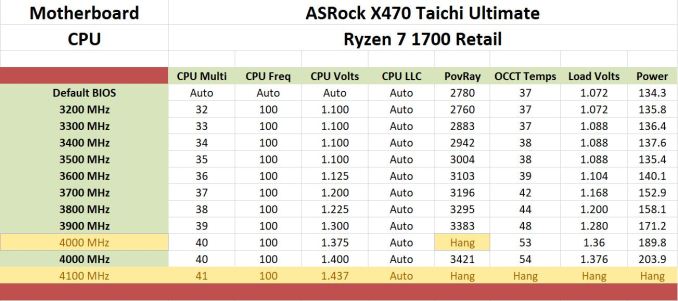The ASRock X470 Taichi Ultimate Motherboard Review: Aquantia 10GbE on Ryzen
by Gavin Bonshor on August 2, 2018 9:00 AM ESTRyzen Overclocking
As it currently stands, all of the Ryzen and Ryzen 2 desktop processors on the market all feature unlocked multipliers which puts the burden of overclockability onto the motherboard vendors to ensure that users have the right tools for the job. The X470 Taichi Ultimate has a colossal power delivery and users looking to push their unlocked Ryzen processor beyond the rated specifications shouldn’t have too much problem here; not just for the overkill phase count, but the quality of the power delivery itself. The BIOS is somewhat easy to navigate and all of the overclocking options can be found within the OC Tweaker subsection.
The Taichi Ultimate does not have any auto overclocking features outside of the ability to load XMP profiles on the memory, so all and any CPU frequency and APU/PCIE frequency if a user wishes to use an APU such as the Ryzen 5 2400G has to be done manually. To do so, setting the overclock mode setting from auto to manual allows users to customize and tweak options including CPU Frequency and CPU voltage; two vital settings for overclocking CPU core frequency.
While the best Ryzen 7 1000-series silicon can achieve clock speeds of up to 4.2/4.3 GHz with ambient cooling, our AM4 motherboard test bench Ryzen 7 1700 sample has only run up to 4.0 GHz stable with voltages ranging from 1.36-1.4 volts.
Methodology
Our standard overclocking methodology is as follows. We select the automatic overclock options and test for stability with POV-Ray and OCCT to simulate high-end workloads. These stability tests aim to catch any immediate causes for memory or CPU errors.
For manual overclocks, based on the information gathered from previous testing, starts off at a nominal voltage and CPU multiplier, and the multiplier is increased until the stability tests are failed. The CPU voltage is increased gradually until the stability tests are passed, and the process repeated until the motherboard reduces the multiplier automatically (due to safety protocol) or the CPU temperature reaches a stupidly high level (100ºC+). Our test bed is not in a case, which should push overclocks higher with fresher (cooler) air.
Overclocking Results
Our Ryzen 7 1700 CPU does have a limitation between 3.9 GHz and 4.0 GHz; at least on the boards, we have tested thus far. This is down to silicon lottery and a combination of a sharp ramp of voltage to temperature when moving up each different step; therefore, cutting out/throttling due to thermal limitations when pushed too far on ambient cooling.
At the time of testing, the motherboard had a tendency to undervolt the processor with a full load applied, although not by an excessive amount and not one which would cause instability issues in testing other than at 3.9 GHz when the undervolting proved insufficient for the load applied. Interestingly enough, our sample even managed to boot up at 4.1 GHz with a set voltage of 1.437 V, although this was very unstable when any load was applied. Our maximum stable overclock achieved was 4.0 GHz at 1.4 V, although the motherboard did settle at 1.376 V under load, even though the overclock did fail in Pov-Ray with a similar set voltage at 3.9 GHz as previously noted. A notable and consistent increase in Pov-Ray performance was apparent as each frequency strap was increased.












41 Comments
View All Comments
willis936 - Tuesday, September 25, 2018 - link
In the DPC Latency section of the System Performance page:"While none of the manufacturers of the boards tested on the AM4 socket so far have been optimized for DPC latency,"
Am I to understand that sub 100 us is being considered "not optimized for DPC latency" while only two of the current list of coffee lake tested mobos approach 100 us are?
From the ASUS B360 review today:
https://www.anandtech.com/show/13105/the-asus-b360...
"Our DPC latency results for the B360-G Gaming 122 µs which is about par for the course after our minor script adjustments."
Is this an oversight or is there something I'm missing? It looks like the AM4 platform is currently ahead of coffee lake in terms of DPC latency.